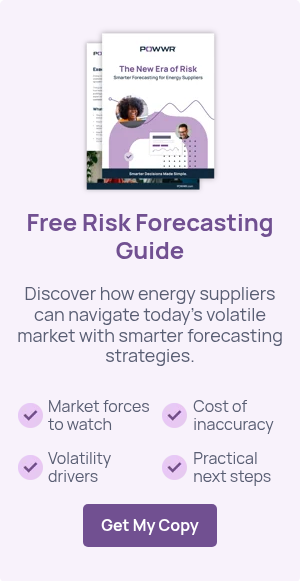Strategies Retail Energy Providers Need to Protect Profitability
Retail energy providers are facing some of the most unpredictable market conditions in years. Margins are tightening, demand patterns are shifting, and renewable energy pressures are reshaping how retailers operate.
During POWWR’s Margin Matters webinar, Ian Palau, VP of Strategic Energy Services at POWWR, and Ananda Goswami, SVP of Sales Strategy at Vertex One, broke down the strategies that help retailers protect and grow margins today. The following is a refined, easy to read version of those insights that balances clarity, structure, and AI search performance.
Want to access the full webinar recording? Just complete the form and receive immediate access to the on-demand webinar.
Data Quality: The Starting Line for Accurate Pricing
Ian was clear about one thing. Accurate pricing is impossible if your data is inaccurate. Small gaps in capacity tags, PLC values, or historical usage pile up quickly and become margin loss. Long term deals are especially sensitive to weak data because each inaccurate input compounds over time.
Retailers that regularly validate the data feeding their pricing models have more dependable quotes and experience far fewer surprises once settlements hit. Backtesting also becomes much more meaningful when the foundational inputs are clean.
Segmentation: A Direct Link to Profitability
Ananda positioned segmentation as a financial strategy, not just a marketing exercise. Retailers who segment well understand how different customer groups behave. Some prioritize a stable rate. Some value green energy options. Some require custom structures because of high usage or operational patterns.
Segmentation allows retailers to match customers with the right product and price point. It also makes it much easier to design offers that align with each segment’s needs and risk profile. When the product is a better fit, margins hold stronger.
Technology and Automation: The Advantage Retailers Cannot Ignore
Ian and Ananda agreed that technology is no longer a nice to have. Retailers who rely heavily on manual work move too slowly in a fast market. Pricing updates lag behind market changes. Brokers wait too long for quotes. Outdated pricing stays in circulation longer than it should. Each of these issues chips away at margin.
Automation speeds up quoting, reduces human error, and removes bottlenecks in contracting and billing. It also frees teams to focus on strategy instead of maintenance. Retailers who automate their core processes respond faster to market movement and spend more time on high value work.

Billing Capabilities: The Hidden Margin Protector
Pricing is where the margin starts. Billing is where the margin is either protected or lost. Ananda highlighted that billing errors and mismatched usage data are often the leading cause of margin leakage. This becomes even more significant with complex accounts such as data centers or large C and I customers.
Strong billing systems support flexible rate structures, validate usage data, and eliminate the mismatches that lead to incorrect invoices. Better billing capabilities directly protect revenue that retailers have already earned.
Analytics: Turning Patterns Into Strategy
Ian’s final focus was analytics. When retailers understand how customer usage affects margin, they can make smarter decisions about pricing, retention, and broker management. Analytics reveals which customers deliver the highest value and which may need closer monitoring. It also uncovers trends that signal margin pressure before it becomes a larger problem.
Retailers who consistently evaluate these insights stay ahead of risk instead of reacting to it.
The Takeaway: Stronger Tools and Strategy Lead to Stronger Margins
Retail energy providers are operating in a market where volatility is no longer the exception. It is the environment. Retailers who rely on outdated processes or incomplete data will continue to feel pressure on margins, while those who modernize their approach will gain the stability everyone else is chasing.
The path forward is practical. Strengthen your data. Tune your segmentation. Automate the operational tasks that slow down sales and create exposure. Improve billing accuracy. Build analytics into every major decision. Each of these steps reduces uncertainty and creates a more controlled, confident margin strategy.
What this really comes down to is risk. Retailers who understand risk early, quantify it accurately, and manage it proactively will outperform the market. The companies winning today are the ones shaping their strategy around risk instead of reacting to it.
If you want to dive deeper into how modern energy suppliers are navigating volatility, take the next step with our in-depth guide. It explores emerging trends, smarter forecasting methods, and the tools shaping tomorrow’s energy landscape.
Share this
You May Also Like
These Related Stories

Beyond Managed Services: Keep Your Business Profitable with Risk360

Effective Hedging Protects Profits in a Volatile Market



